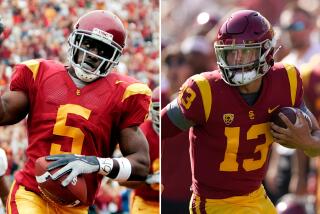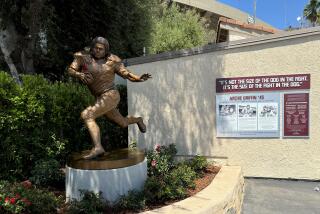Heisman Race: What Should Count Most?
Maybe the design of the Heisman Trophy should be forever altered. Instead of the now-famous, 25-pound, 13 1/2-inch, bronze statue of an old-time football hero, perhaps the award should be a glass-encased fax sheet with the winner’s game-by-game statistics.
In the eyes of many, that is what college football’s most prestigious individual prize has become. What is supposed to go to the best collegiate player in the country recently has gone, nearly without exception, to the guy who has put up the best offensive numbers.
This year’s race, which is still almost as wide-open as when the season began, has stirred an inordinate amount of debate. The merits of a player’s stats vs. his worth to the team will be argued until, and possibly after, the voting is announced Dec. 2 at New York’s Downtown Athletic Club.
Certainly, the single-most controversial statement regarding the 1989 Heisman race was made this week by Syracuse Coach Dick MacPherson.
Known for his bluntness in a profession filled with cliche-mongers, this time MacPherson went mouth first with both feet.
Asked about Indiana tailback Anthony Thompson’s record-setting 377-yard rushing performance last week, MacPherson scoffed.
“To me, he should be banned from the Heisman,” MacPherson said. “That’s a joke. To do that against Michigan, then you win the Heisman. Don’t do it against Wisconsin and try to impress me.”
Thompson, who leads the nation’s Division I-A players in rushing yardage per game (168.2) and points per game (16.4), is considered one of a handful of legitimate late-season candidates for the trophy.
Others thought to be among the leading contenders, for various reasons, are three quarterbacks: Houston’s Andre Ware (stats), West Virginia’s Major Harris (one-man offense) and Notre Dame’s Tony Rice (see eight other Fighting Irish winners).
Asked this week if he thought he would win the Heisman, Harris said, “Not a chance. This is really a two-man race between that running back at Indiana and that quarterback at Houston. I’m not in in the race.”
Said Rice: “I’m not thinking about that. What I want is another (national championship) ring.”
From a strictly statistical standpoint, Ware and Thompson have moved to center stage. Ware has set nine National Collegiate Athletic Association records and, with 40 touchdown passes, is eight shy of breaking Jim McMahon’s all-time, one-season mark. Thompson, who broke Rueben Mayes’ record of 357 yards in a game, is also the National Collegiate Athletic Association’s all-time touchdown leader (60).
“I don’t think you can ignore the numbers,” Houston Coach Jack Pardee said of Ware.
But there are some factors going against Ware and Thompson.
Houston is on probation and not on television, and Ware would be the first player in that type of situation to win the award. (Barry Sanders won it last year with very little television exposure, after which Oklahoma State went on probation.)
Indiana is 5-4, and, against the top two rushing defenses in the Big Ten, Michigan and Michigan State, Thompson was held to 172 yards on 58 carries. His longest run from scrimmage this year is 35 yards, making him not the kind of game-buster you expect to see win the Heisman.
In defending the way he used Thompson last week, during a 38-17 victory over Wisconsin, Indiana Coach Bill Mallory said, “You can’t ask a kid to put more into his football. He trains and conditions himself to do that. You’ve got some guys who carry 52 times and you have to give them mouth-to-mouth.”
While Thompson and Ware continue their onslaught against the record books, Harris might have resuscitated his chances with back-to-back games of 300 yards or more total offense against Penn State and Rutgers. There is certainly some sentiment -- albeit from the East -- for Harris.
Consider that Harris was the leading returning Heisman vote-getter from last year after the top four, including Sanders, went to the National Football League. Consider, too, that West Virginia lost its entire offensive line from last season, as well as two of its top receivers.
“If I had a vote for the Heisman, I’d go with Major because of the job he’s done,” MacPherson said of the player who has led the Mountaineers to a 7-2-1 record, and could finish with more than 2,000 yards passing and close to 1,000 yards rushing. “He has clearly done something special.”
Tom Luicci of The (Newark, N.J.) Star-Ledger, who does have a vote, will cast his for Harris. He said statistics alone shouldn’t determine the Heisman. “If it was just stats, let the NCAA hand it out,” said Luicci. “But it’s not.”
One factor that always seems to rule out candidates is age. Call it the wait-till-next year syndrome. It might affect Ware, a junior, and certainly will put Colorado quarterback Darian Hagan and Notre Dame flanker-tailback-kick-returner Raghib Ismail, both sophomores, back in the pack. But their stats deserve some attention.
Statistics are one reason that Rice won’t win. Though he has made big plays in big games, he has had too many days when he was 1-for-7 passing and had 55 yards rushing. The party line in South Bend, Ind., is that opposing defenses are geared to stop Rice, but the same is true for most of the other top contenders.
In fact, the emergence of Ismail, as well as the abundance of tailbacks at Notre Dame, should give Rice more of an opportunity to stand out. Conversely, Thompson, Emmitt Smith of Florida and Penn State’s Blair Thomas play on teams with virtually no passing game.
But Notre Dame Coach Lou Holtz, who still won’t vote his team No. 1 in the country, said this week that he would pick Rice if he had a say in the Heisman.
“I wouldn’t trade Tony Rice for any player in the country -- bar none,” Holtz said. “I don’t know another quarterback to do the things that Tony Rice has done. The main thing with Tony Rice is that he’s a complete quarterback, a leader, a winner. He makes the throws when he has to. I don’t know if anybody can get the statistics for us the way we do things.”
When Tim Brown won the Heisman as a Notre Dame senior in 1987, he didn’t have the kind of statistics as during his junior year. Nor did he match up in a numbers game with Syracuse quarterback Don McPherson. It didn’t matter that the Fighting Irish lost their last three games after an 8-1 start, or that Syracuse finished 11-0-1 and nearly won the national championship.
Momentum from his junior year, and an early-season game against Michigan State -- in which he ran back two successive punts for touchdowns -- gave Brown an insurmountable lead on the field. Even Dick MacPherson was not disturbed by Brown’s getting the award.
“I think Tim Brown did some things to excite a lot of people,” said MacPherson. “For a guy like Donnie McPherson to come out of nowhere like he did (in the Heisman voting) really helped him. I was very happy for Tim Brown. What we really have to understand is that a deserving young man is usually going to get the award.”
Deserving, perhaps. But not always the best college football player in the country.
More to Read
Go beyond the scoreboard
Get the latest on L.A.'s teams in the daily Sports Report newsletter.
You may occasionally receive promotional content from the Los Angeles Times.










